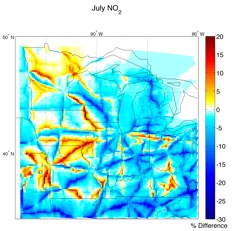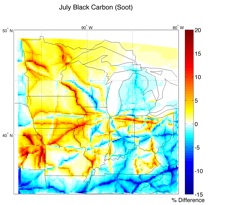For Midwesterners, more boxcars mean cleaner air
Shifting a fraction of truck-borne freight onto trains would have an outsized impact on air quality in the Midwest, according to researchers at the University of Wisconsin–Madison.
Much of that impact boils down to simple efficiency, according to Erica Bickford, a graduate student in UW–Madison’s Nelson Institute for Environmental Studies. For each ton they carry, long-distance trucks go about 150 miles on a gallon of diesel fuel. Trains can move a ton more than 400 miles per gallon.
Shifting from road to rail 500 million tons of the freight passing through or to the Midwest would make a large dent in the carbon dioxide spilled into the air by the movement of goods.
“There’s a 31 percent decrease in carbon dioxide produced by freight shipping in the region, and that’s straight from emissions,” says Bickford, who made a model of freight traffic in 10 Midwestern states from Kansas to Ohio that she will present today in San Francisco at the fall meeting of the American Geophysical Union. “It’s 21 million metric tons of CO2, the equivalent of what’s produced by about 4 million cars.”
But carbon dioxide mixes fairly evenly in the atmosphere, spreading its effects around the globe. Bickford’s study accounts for weather patterns and the way particular pollutants are distributed to determine how long other products of diesel engines — like black carbon soot and the ozone ingredient and lung irritant nitrogen dioxide (NO2) — linger near their sources.

Show in blue, falling local levels of the pollutant nitrogen oxide are a benefit expected to follow a shift of freight from trucks to trains, according to a UW–Madison study. Areas shaded red represent areas close to rail corridors that would experience an increase in nitrogen oxide pollution.
“The result is a much more thorough and local idea of the differences between truck and rail shipping,” says Tracey Holloway, director of the Nelson Institute’s Center for Sustainability and the Global Environment and Bickford’s advisor. “If you’re emitting CO2 in Indiana or India it has the same impact. But something like soot, that has local impact.”
More rail traffic would mean more pollutants near the tracks, but relief near roads frequented by trucks — a tradeoff is unbalanced in favor of more densely populated areas.
“Black carbon and NO2 are harmful to everyone’s health,” Bickford says. “But because more people live near roads than railroad tracks, more people would benefit from the shifts in these pollutants.”
As much as 16 percent less black carbon soot would linger near roads with heavy shipping traffic, according to Bickford’s model, while the increase around rail corridors would be as high as 20 percent. Nitrogen dioxide would plummet by as much as 30 percent near roads, but rise by as much as 20 percent near railroad tracks.

Show in blue, falling local levels of black carbon soot — a pollutant pumped into the air by diesel engines — are a benefit expected to follow a shift of freight from trucks to trains, according to the study. Areas shaded red represent areas close to rail corridors that would experience an increase in black carbon pollution.
Holloway’s research group is already working on further modeling to explore connected changes in the number of asthma and heart disease cases.
The effects of greater rail use would be particularly noticeable in the middle of the country, according to Bickford.
“We’re sort of a freight crossroads in the Midwest,” says Bickford, whose work was funded by the National Center for Freight and Infrastructure Research and Education at UW–Madison. “International shipping comes into the country on the coasts and then passes through our backyard on the way to its destination.”
The study limited hypothetical changes in shipping to trips of more than 400 miles to ensure a cost savings for shippers, and to cargo — such as automobiles and non-perishable food — that could handle the slower trip in railcars. The 500 million tons Bickford selected for travel by rail represent about 5 percent of U.S. truck freight by weight.
“These aren’t pie-in-the-sky figures,” Holloway says. “They are reasonable and achievable.”
And they come with non-pollution benefits, like reduced traffic congestion, wear on roads and demand for diesel fuel.
“Truck freight travels on publicly-funded roads, rail traffic on privately-built tracks,” Bickford says. “But these benefits could be an impetus for public investment in rail infrastructure.”




